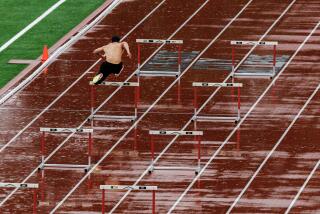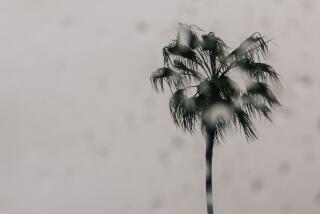Historic July Rain Produces Snarls, Smiles
A rare July rainstorm doused Los Angeles on Monday, triggering power failures, traffic snarls, mudslides--and smiles among parched Southern Californians suffering through the fifth year of drought.
A dusty gauge at the Civic Center collected .13 of an inch of rain--the first time that rain has ever been measured in Los Angeles on a July 8, officials said.
The rain was more like a heavy drizzle in some places. But meteorologists said it was enough to make this month the third wettest July since 1877, when local weather records-keeping was started. The wettest July ever was in 1886, when .24 of an inch of rain fell during the month, officials said. In 1988, .18 of an inch was recorded during July.
By the time the rain ended at about noon Monday, .10 of an inch had fallen at Los Angeles International Airport, .11 of an inch was measured at Long Beach and .08 of an inch noted at Catalina Island, officials said.
Weather experts said the surprise rain was not caused by atmospheric changes after the recent volcanic eruptions in Japan and the Philippines.
They predicted that lingering clouds today would give way to summerlike sunshine by this afternoon.
A “turning and churning” high-pressure system about three miles up caused Monday’s rain, said Michael Schlesinger, a forecaster for WeatherData Inc., which provides forecasts for The Times. The movement pulled in moisture from the Pacific and from the Gulf of Mexico as the system drifted northeast toward Nevada and Utah, he said.
Whatever its cause, Los Angeles residents suffering through water rationing were delighted and surprised by the rain. So were their lawns.
“I heard a dripping sound, I thought, oh my gosh, maybe I’d left a faucet on overnight,” said Pat Rowe, a spokeswoman for the National Weather Service who lives in West Los Angeles. “I got up and checked everything and then looked out the window and there it was.”
The rain forced workers at a Wilshire Boulevard pizzeria to stack their restaurant’s outdoor tables and chairs beneath an overhang to keep them dry.
“Usually we have a line of people waiting to be seated outside at lunch, but not today,” laughed waitress Inge Liem. “I never expected to see this, but I’m glad. The plants need it.”
Employees of Pink’s hotdog stand on La Brea Avenue in Hollywood stretched blue plastic tarpaulins over their eatery’s patio umbrellas to keep them--and their customers--dry. Lunchtime diner Byron Smith of the Athens area was watching droplets roll off the covering as he munched on a chili dog.
“It’s raining because I washed my car yesterday,” he laughed. “And because my lawn was crying out, ‘I’m thirsty! I’m thirsty!’ ”
At a bus stop in downtown Los Angeles, Cata Arrata of El Monte positioned herself under an umbrella and out of the splash range of RTD buses traveling through flooded gutters along Spring Street. “Who’d expect rain in July? In the middle of a drought?” she asked.
In Playa del Rey, conservationists Brenda Goeden and Joe Crocker huddled under an environmental poster to keep dry as they attended an outdoor press conference that unveiled ideas for cleaning up the Santa Monica Bay.
In Los Angeles, meantime, the rain prompted county health officials to issue an immediate suggestion of their own: swimmers and beach-goers, they said, should stay away from storm drains emptying into the bay once sunny weather returns.
“Urban runoff” from streets and yards rinsed by the rain can contain large amounts of coliform bacteria associated with animal feces and soil, said Dr. Caswell A. Evans, director of public health programs and services.
Monday morning’s freeway wash-down was blamed for triggering 39 accidents that snarled commuter traffic and made thousands late for work, officials of the California Highway Patrol said.
“The number of accidents typically triples the first day it rains,” said CHP spokesman Sgt. Mike Brey of Glendale. “But I’m still glad it rained. We desperately needed it.”
At least one group was disagreeing Monday. Southland tourists weren’t seeing any silver lining in the clouds.
“It’s just our bad luck,” shrugged visitor Sylke Van Der Hayden of Antwerp, Belgium, as she strolled though the fog-shrouded Hollywood Bowl and shook puddles of water off its green canvas seats.
Heat and sunshine is what they came for, said her companion, Frederic Laurent. “It’s exceptional for us to have good weather in Belgium. For our trip, all we brought were T-shirts,” he said.
Police in Torrance blamed the rain for causing a minor mudslide across parts of Hawthorne Boulevard at Newton Avenue.
In Venice, the storm triggered a power failure about 7:50 a.m., a spokeswoman for the Los Angeles Department of Water and Power said.
Authorities in Hesperia reported flash-flood conditions after a 45-minute downpour forced some residents of the San Bernardino County community to put out sandbags.
But few problems were reported in Ventura and Orange counties, although “I’d say this was about the biggest non-beach day in a long time,” said Lt. Steve Davidson, a marine safety officer with the Huntington Beach city lifeguard office.
The Rain
24-hour total: 0.13 in.
Storm total: 0.13 in.
Monthly total: 0.13 in.
Total for season: 0.13 in.
Last season to date: 0.00 in.
Normal season to date: 0.00 in.
Figures, based on 4 p.m. readings at the Los Angeles Civic Center, are compiled by the National Weather Service, which provides no later data.
Raindrops in July
In July, there is only a one in 20 chance of rain in the Los Angeles Basin and Orange County. Monday’s unusual rain was due to a combination of weather events.
1. Off the coast, an upper level low-pressure system from Mexico directed moisture from the eastern Pacific toward the Southland.
2. Meanwhile, an upper-level high-pressure system located over the Southwest sent moisture into this region from the Gulf of Mexico.
3. The systems overwhelmed the high-pressure system over the eastern Pacific, which ordinarily prevents moisture from entering the Southland this time of year.
Source: Weather Data
More to Read
Sign up for Essential California
The most important California stories and recommendations in your inbox every morning.
You may occasionally receive promotional content from the Los Angeles Times.











